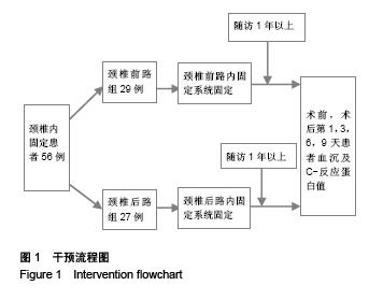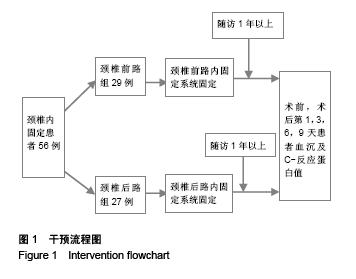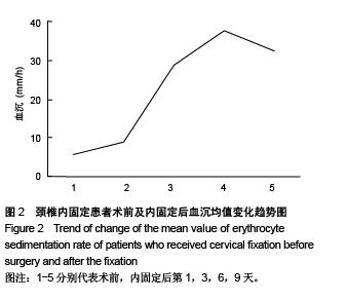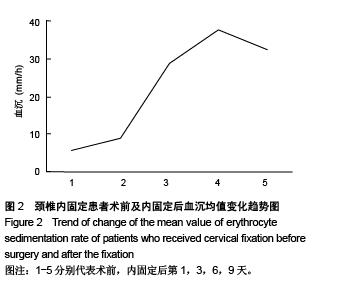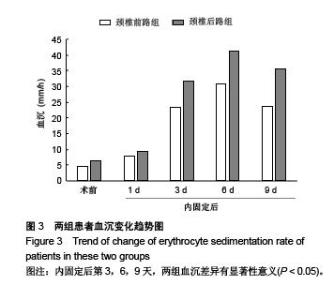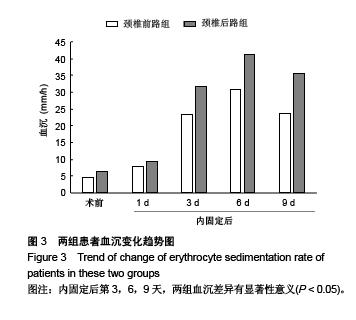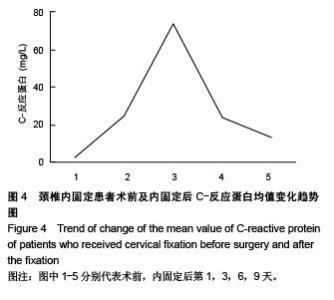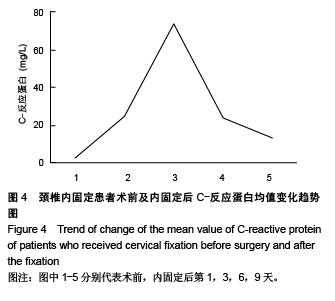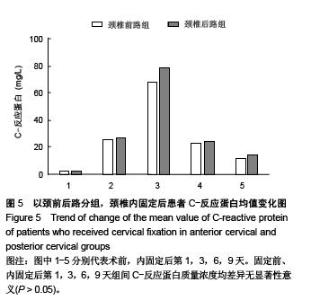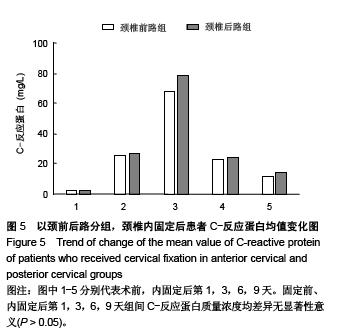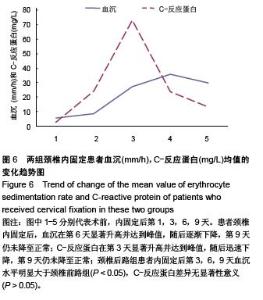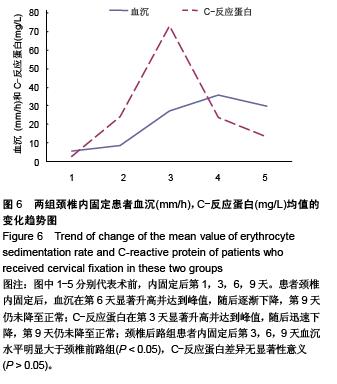Chinese Journal of Tissue Engineering Research ›› 2015, Vol. 19 ›› Issue (53): 8560-8566.doi: 10.3969/j.issn.2095-4344.2015.53.006
Previous Articles Next Articles
The trend of change and clinical significance of early-phase inflammatory indices after cervical fixation
Liang Chen, Sun Jian-min, Cui Xin-gang, Jiang Zhen-song, Li Tao
- Department of Spine Surgery, Provincial Hospital Affiliated to Shandong University, Jinan 250012, Shandong Province, China
-
Received:2015-11-12Online:2015-12-24Published:2015-12-24 -
Contact:Sun Jian-min, M.D., Chief physician, Professor, Doctoral supervisor, Department of Spine Surgery, Provincial Hospital Affiliated to Shandong University, Jinan 250012, Shandong Province, China -
About author:Liang Chen, Master, Physician, Department of Spine Surgery, Provincial Hospital Affiliated to Shandong University, Jinan 250012, Shandong Province, China -
Supported by:the Science and Technology Development Program of Shandong Province, China, No. 2012GGB14026
CLC Number:
Cite this article
Liang Chen, Sun Jian-min, Cui Xin-gang, Jiang Zhen-song, Li Tao. The trend of change and clinical significance of early-phase inflammatory indices after cervical fixation [J]. Chinese Journal of Tissue Engineering Research, 2015, 19(53): 8560-8566.
share this article
| [1] Pull TGA, van Laarhoven CJ, Cohen DB. Incidence of surgical site infection following adult spinal deformity surgery: an analysis of patient risk. Eur Spine J. 2010;19(6):982-988.
[2] Pull TGA, Mohamed AS, Skolasky RL, et al. The presentation, incidence, etiology, and treatment of surgical site infections after spinal surgery. Spine (Phila Pa 1976). 2010;35(13):1323-1328.
[3] Hegde V, Meredith DS, Kepler CK, et al. Management of postoperative spinal infections. World J Orthop. 2012;3(11): 182-189.
[4] Gerometta A, Rodriguez OJ, Bitan F. Infections in spinal instrumentation. Int Orthop. 2012;36(2):457-464.
[5] Simchen E, Stein H, Sacks TG, et al. Multivariate analysis of determinants of postoperative wound infection in orthopaedic patients. J Hosp Infect. 1984;5(2):137-146.
[6] Whitehouse JD, Friedman ND, Kirkland KB, et al. The impact of surgical-site infections following orthopedic surgery at a community hospital and a university hospital: adverse quality of life, excess length of stay, and extra cost. Infect Control Hosp Epidemiol. 2002;23(4):183-189.
[7] Park KK, Kim TK, Chang CB, et al. Normative Temporal Values of CRP and ESP in Unilateral and Staged Bilateral TKA. Clin Orthop Relat Res. 2008;466(1):179-188.
[8] Piper KE, Fernandez-Sampedro M, Steckelberg KE, et al. C-reactive protein, erythrocyte sedimentation rate and orthopedic implant infection. PLoS One. 2010;5(2):e9358.
[9] Huang TJ, Hsu RW, Li YY, et al. Less systemic cytokine response in patients following microendoscopic versus open lumbar discectomy. J Orthop Res. 2005;23(2):406-411.
[10] Lee JH, Lee JH, Kim JB, et al. Normal range of the inflammation related laboratory findings and predictors of the postoperative infection in spinal posterior fusion surgery. Clin Orthop Surg. 2012;4(4):269-277.
[11] Choi MK, Kim SB, Kim KD, et al. Sequential changes of plasma c-reactive protein, erythrocyte sedimentation rate and white blood cell count in spine surgery: comparison between lumbar open discectomy and posterior lumbar interbody fusion. J Korean Neurosurg Soc. 2014;56(3):218-223.
[12] Houten JK, Tandon A. Comparison of postoperative values for C-reactive protein in minimally invasive and open lumbar spinal fusion surgery. Surg Neurol Int. 2011;2:94.
[13] Kraft CN, Kruger T, Westhoff J, et al. CRP and leukocyte-count after lumbar spine surgery: fusion vs. nucleotomy. Acta Orthop. 2011;82(4):489-493.
[14] Codine P, Barbotte E, Denis-Laroque F, et al. C-reactive protein, leukocyte count and D-dimer monitoring after orthopedic surgery: early diagnosis of infectious or thromboembolic complications. Part one: C-reactive protein and leukocyte count as an aid in diagnosing postoperative infection. Ann Readapt Med Phys. 2005;48(8):590-597.
[15] Neumaier M, Braun KF, Sandmann G, et al. C-Reactive Protein in Orthopaedic Surgery. Acta Chir Orthop Traumatol Cech. 2015;82(5):327-331.
[16] Mok JM, Pekmezci M, Piper SL, et al. Use of C-reactive protein after spinal surgery: comparison with erythrocyte sedimentation rate as predictor of early postoperative infectious complications. Spine (Phila Pa 1976). 2008;33(4): 415-421.
[17] Kong CG, Kim YY, Ahn CY, et al. Diagnostic usefulness of white blood cell and absolute neutrophil count for postoperative infection after anterior cervical discectomy and fusion using allograft and demineralized bone matrix. Asian Spine J. 2013;7(3):173-177.
[18] Davis N, Curry A, Gambhir AK, et al. Intraoperative bacterial contamination in operations for joint replacement. J Bone Joint Surg Br. 1999;81(5):886-889.
[19] Wimmer C, Gluch H, Franzreb M, et al. Predisposing factors for infection in spine surgery: a survey of 850 spinal procedures. J Spinal Disord. 1998;11(2):124-128.
[20] Weinstein MA, Mccabe JP, Cammisa FJ. Postoperative spinal wound infection: a review of 2,391 consecutive index procedures. J Spinal Disord. 2000;13(5):422-426.
[21] Olshaker JS, Jerrard DA. The erythrocyte sedimentation rate. J Emerg Med. 1997;15(6):869-874.
[22] Dupont C, Rodenbach J, Flachaire E. The value of C-reactive protein for postoperative monitoring of lower limb arthroplasty. Ann Readapt Med Phys. 2008;51(5):348-357.
[23] Lal SK, Jacob KC, Nagi ON, et al. Variations of some plasma components after closed fractures. J Trauma. 1976;16(3): 206-211.
[24] Sturdee SW, Giannoudis PV. C-reactive protein in patients who had operative fracture treatment. Clin Orthop Relat Res. 2004;(419):318-319.
[25] Dipaola CP, Saravanja DD, Boriani L, et al. Postoperative infection treatment score for the spine (PITSS): construction and validation of a predictive model to define need for single versus multiple irrigation and debridement for spinal surgical site infection. Spine J. 2012;12(3):218-230.
[26] Kuhn MG, Lenke LG, Bridwell KH, et al. The utility of erythrocyte sedimentation rate values and white blood cell counts after spinal deformity surgery in the early (≤3 months) post-operative period. J Child Orthop. 2012;6(1):61-67.
[27] Takahashi J, Ebara S, Kamimura M, et al. Early-phase enhanced inflammatory reaction after spinal instrumentation surgery. Spine (Phila Pa 1976). 2001;26(15):1698-1704.
[28] Kang BU, Lee SH, Ahn Y, et al. Surgical site infection in spinal surgery: detection and management based on serial C-reactive protein measurements. J Neurosurg Spine. 2010; 13(2):158-164.
[29] Lazennec JY, Fourniols E, Lenoir T, et al. Infections in the operated spine: update on risk management and therapeutic strategies. Orthop Traumatol Surg Res. 2011;97(6 Suppl): S107-S116.
[30] Chung YG, Won YS, Kwon YJ, et al. Comparison of Serum CRP and Procalcitonin in Patients after Spine Surgery. J Korean Neurosurg Soc. 2011;49(1):43-48. |
| [1] | Chen Ziyang, Pu Rui, Deng Shuang, Yuan Lingyan. Regulatory effect of exosomes on exercise-mediated insulin resistance diseases [J]. Chinese Journal of Tissue Engineering Research, 2021, 25(25): 4089-4094. |
| [2] | Chen Yang, Huang Denggao, Gao Yuanhui, Wang Shunlan, Cao Hui, Zheng Linlin, He Haowei, Luo Siqin, Xiao Jingchuan, Zhang Yingai, Zhang Shufang. Low-intensity pulsed ultrasound promotes the proliferation and adhesion of human adipose-derived mesenchymal stem cells [J]. Chinese Journal of Tissue Engineering Research, 2021, 25(25): 3949-3955. |
| [3] | Yang Junhui, Luo Jinli, Yuan Xiaoping. Effects of human growth hormone on proliferation and osteogenic differentiation of human periodontal ligament stem cells [J]. Chinese Journal of Tissue Engineering Research, 2021, 25(25): 3956-3961. |
| [4] | Sun Jianwei, Yang Xinming, Zhang Ying. Effect of montelukast combined with bone marrow mesenchymal stem cell transplantation on spinal cord injury in rat models [J]. Chinese Journal of Tissue Engineering Research, 2021, 25(25): 3962-3969. |
| [5] | Gao Shan, Huang Dongjing, Hong Haiman, Jia Jingqiao, Meng Fei. Comparison on the curative effect of human placenta-derived mesenchymal stem cells and induced islet-like cells in gestational diabetes mellitus rats [J]. Chinese Journal of Tissue Engineering Research, 2021, 25(25): 3981-3987. |
| [6] | Hao Xiaona, Zhang Yingjie, Li Yuyun, Xu Tao. Bone marrow mesenchymal stem cells overexpressing prolyl oligopeptidase on the repair of liver fibrosis in rat models [J]. Chinese Journal of Tissue Engineering Research, 2021, 25(25): 3988-3993. |
| [7] | Liu Jianyou, Jia Zhongwei, Niu Jiawei, Cao Xinjie, Zhang Dong, Wei Jie. A new method for measuring the anteversion angle of the femoral neck by constructing the three-dimensional digital model of the femur [J]. Chinese Journal of Tissue Engineering Research, 2021, 25(24): 3779-3783. |
| [8] | Meng Lingjie, Qian Hui, Sheng Xiaolei, Lu Jianfeng, Huang Jianping, Qi Liangang, Liu Zongbao. Application of three-dimensional printing technology combined with bone cement in minimally invasive treatment of the collapsed Sanders III type of calcaneal fractures [J]. Chinese Journal of Tissue Engineering Research, 2021, 25(24): 3784-3789. |
| [9] | Qian Xuankun, Huang Hefei, Wu Chengcong, Liu Keting, Ou Hua, Zhang Jinpeng, Ren Jing, Wan Jianshan. Computer-assisted navigation combined with minimally invasive transforaminal lumbar interbody fusion for lumbar spondylolisthesis [J]. Chinese Journal of Tissue Engineering Research, 2021, 25(24): 3790-3795. |
| [10] | Hu Jing, Xiang Yang, Ye Chuan, Han Ziji. Three-dimensional printing assisted screw placement and freehand pedicle screw fixation in the treatment of thoracolumbar fractures: 1-year follow-up [J]. Chinese Journal of Tissue Engineering Research, 2021, 25(24): 3804-3809. |
| [11] | Shu Qihang, Liao Yijia, Xue Jingbo, Yan Yiguo, Wang Cheng. Three-dimensional finite element analysis of a new three-dimensional printed porous fusion cage for cervical vertebra [J]. Chinese Journal of Tissue Engineering Research, 2021, 25(24): 3810-3815. |
| [12] | Wang Yihan, Li Yang, Zhang Ling, Zhang Rui, Xu Ruida, Han Xiaofeng, Cheng Guangqi, Wang Weil. Application of three-dimensional visualization technology for digital orthopedics in the reduction and fixation of intertrochanteric fracture [J]. Chinese Journal of Tissue Engineering Research, 2021, 25(24): 3816-3820. |
| [13] | Sun Maji, Wang Qiuan, Zhang Xingchen, Guo Chong, Yuan Feng, Guo Kaijin. Development and biomechanical analysis of a new anterior cervical pedicle screw fixation system [J]. Chinese Journal of Tissue Engineering Research, 2021, 25(24): 3821-3825. |
| [14] | Lin Wang, Wang Yingying, Guo Weizhong, Yuan Cuihua, Xu Shenggui, Zhang Shenshen, Lin Chengshou. Adopting expanded lateral approach to enhance the mechanical stability and knee function for treating posterolateral column fracture of tibial plateau [J]. Chinese Journal of Tissue Engineering Research, 2021, 25(24): 3826-3827. |
| [15] | Zhu Yun, Chen Yu, Qiu Hao, Liu Dun, Jin Guorong, Chen Shimou, Weng Zheng. Finite element analysis for treatment of osteoporotic femoral fracture with far cortical locking screw [J]. Chinese Journal of Tissue Engineering Research, 2021, 25(24): 3832-3837. |
| Viewed | ||||||
|
Full text |
|
|||||
|
Abstract |
|
|||||
